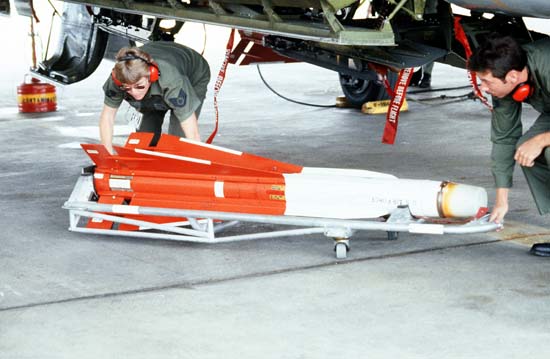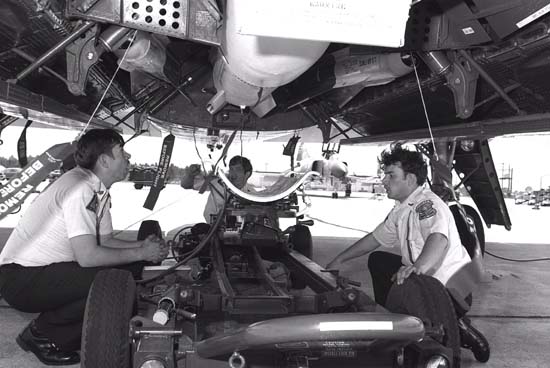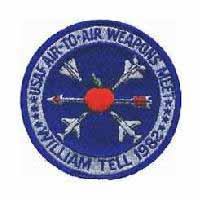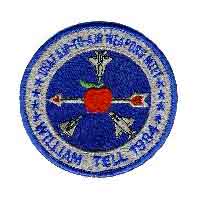|
|
|
WEAPONS LOAD COMPETITION |
|
|
 |
|
|
|
Since the early 50's weapons loading competitions have been a
long-standing tradition with crews in the Air Force. These competitions
were developed from load crews testing their skills and speed against
each other while loading their aircraft for their next missions in the
Korean War.
|
|
|
|
In the U.S. Air Force, the weapons
loader career field is one of the only positions that require a monthly
evaluation to show the knowledge and proficiency in all weapons loading
tasks, with this in mind many units would
hold quarterly competitions to promote morale and to increase
proficiency, knowledge.
|
|
|
|
In 1970, the Aerospace Defense Command held its first command wide
Weapons Load Competitions to spread the benefits of the local
competitions throughout all fighter-interceptor squadrons. Initially,
the competition was open for Aerospace Defense Command Active & Guard
units but in 1977 the contest added Canadian and Alaskan Air Command
units with an air defense mission in NORAD. These yearly competitions
would end in 1981; the best load crews from air defense units would
continue to be recognized at the William Tell Competition.
|
|
|
|
|
|
318TH AT WEAPONS LOAD COMPETITION |
|
|
 |
|
318th FIS Personnel inspect a ATR-2 Genie during the 1978 NORAD
Weapons Loading Competition.
|
|
|
 |
|
|
318th FIS Participates
-
TAC holds load competition |
|
By
TSgt Alan B. Crank,
318 FIS - Northwest Airlifter -
September 1981 |
|
|
|
There will be an Air Defense weapons load competition at Tyndall
AFB, Florida, and Sept 14-25. Alaskan Air Command, Tactical Air Command,
Air National Guard, and Canadian Air Command units with a NORAD air
defense mission have been invited to participate in the competition.
|
|
|
|
The purpose of this competition is to foster a competitive spirit,
give recognition to outstanding load crew performance, promote public
understanding and support for strategic air defense, and raise the
overall standards of excellence in weapons loading.
|
|
|
|
Awards will be presented to the first, second, third and fourth
place load areas in the F-4 category and to the first and second place
in the F-101 aircraft category. The first place winner in each category
will be the NORAD Load Crew of the Year for that aircraft type.
|
|
|
|
A four-man crew from the 318th Fighter Interceptor Squadron has
been chosen by way of a local weapons load off between assigned 318th
FIS load crews. The four-man team selected to go consists of:
TSgt. Alan B. Crank, SSgt. Gerry Romo, Sgt. Kurt A. Reuterdahl, and SrA.
Ronald E. Legarde. Each man has a specific amount of tasks to perform to
eventually arrive at a common goal of a safe and reliable load with the
utmost use of professionalism and integrity.
|
|
|
|
The load condition required to be loaded by the F-106 load crews
consisted of four missiles and one rocket. This will be judged by two or
more judges for technical order compliance, safety, security and command
directives.
|
|
|
|
The maximum allowable time is 22 minutes. The load crew of Crank,
Romo, Legarde, and Reuterdahl has been practicing loads since early
July. As of Aug. 24, the 318th FIS team has completed the load in 17
minutes. This will allow them at least five minutes for extra critical
inspections. They have also been working on acquiring new uniforms,
building and painting a new load tool box, refurbishing the missile
loading and handling frame and missile handling bar. These items of
equipment will be inspected by the judges for serviceability and a point
value deducted for each discrepancy.
|
|
|
|
The load crew will be performing two loads each, having a value of
1,000 points, the tools and equipment have a point value of 200 points.
Each crewmember will be given an academic exam worth 300 points.
|
|
|
|
"If everything falls together this week I believe we will be in
excellent shape for the competition'" said Romo. Our crew is devoting a
lot of free time to this competition" Romo added, "We are going to win
first place as there isn't a better F-106 crew anywhere."
|
|
|
|
We are proud to represent the 318th FIS, 62nd Military Airlift
Wing, and the 25th Air Division in this competition and we will be
giving our best to the Northwest," said Crank.
|
|
|
|
|
|
William Tell Weapons Load Competition |
|
|
 |
 |
|
The ADC / NORAD / TAC Weapons Load Competition shared many
similaries with the William Tell Weapons Meets Load Competition. Below
you will find details for the load competition at 1982 & 1984 William
Tell Weapons Meet.
|
|
|
|
The William Tell Weapons Load Competition is an event involving
loaders from each participating team. The competition consisted of two
loads, an inspection of the load team's tool kit and a written exam for
all team members (not performed after the 1982 competition) for a total
of 40,000 points (in the 1982 competition) and 3,500 points (in the 1984
competition).
|
|
|
|
The top team from each aircraft type is recognized as the Aircraft
Category Best Weapons Load Team, the highest scoring team is named as
the Top Weapons Load Team.
|
|
|
|
Weapons Load Teams
|
|
The number of team members varies from aircraft to aircraft (with
one alternate member), CF-101 teams consisted of five members, four
members for F-106, and F-15 teams, F-4 teams would employ three or four
members. The alternate, in addition to being allowed to replace an
injured or ill primary member, was also able to assist during loads by
connecting, disconnecting, and operating support equipment.
|
|
|
|
Written Exam (1982 - 5,000 points)
|
|
A written exam is given to all team
members including the alternate to test the loaders' basic knowledge of
loading missiles onto their respective aircraft.
|
|
|
|
Toolbox Inspection (1982
- 5,000 points; 1984 - 500 points)
|
|
During the toolbox inspection each tool is checked, each instance
of overdue inspection and calibrations or tool unserviceability resulted
in a 100 point (1982) or 10 point (1984), while minor problems affecting
the servicability of a tool resulted in a 50 point (1982) or 5 point
(1984) deduction. As a part of the Toolbox Inspection technical manuals
were checked; and, if the team failed to record that required
inspections had been performed or if these inspections were found to be
outdated or incomplete , a 100 point (1982) or 10 point (1984) deduction
was assessed for each noted deviation.
|
|
|
|
Load Competition (1982 - 15,000
points - each load; 1984 - 1,500 points each load)
|
|
Each load started at the time specified in the master schedule for
the meet (dependant on weather). Two hours before the scheduled start
time, the unit was told where to park its selected team aircraft for the
load. The team was responsible for having the aircraft towed to the
designated area and repositioning of all load equipment as required to
match the specified pre-load configuration. All supplied support
equipment is inspected for safety hazards.
|
|
|
|
With 15 minutes remaining before the scheduled start of the load,
the load team forms a single line in front of the right wing of the
aircraft, the load crew chief informs the judges that the team is ready
for the load and the aircraft and support equipment is ready for
inspection. If the judges do not find any outstanding safety hazards,
the load is allowed to take place, if the load cannot be completed
safely because of the aircraft or support equipment, the load is
rescheduled with a penalty assessed to the team for failing to reject
the supplied support equipment or providing a defective aircraft.
|
|
|
|
Following the inspection, any final adjustments to the equipment
and aircraft needed for the load are completed by the load crew. At the
published start time, the load crew lines up in the front of the
aircraft and is briefed by the senior judge and then by the load team
crew chief, following the briefing, the load begins.
|
|
|
|
The loads were timed events, which had to be completed within a
specific number of minutes with points deducted from every second taken
beyond the category (aircraft) limit, 5 points (1982) & 0.5 points
(1984). The load times and missile loads for each category is as
follows:
|
|
|
|
|
|
Load Time Limit: 37 minutes (1982) & 35 minutes (1984)
|
|
Armament load: (4) AIM-7 Sparrows & (4) AIM-9 Sidewinders
|
|
|
|
|
|
Load Time Limit: 21 minutes (1982)
|
|
Armament load: (2) AIM-4D Falcons & (2) ATR-2A Genies
|
|
|
|
|
|
Load Time Limit: 21 minutes (1982) & 20 minutes (1984)
|
|
Armament load: (2) AIM-4F Falcon, (2) AIM-4G Falcon & (1) ATR-2A
Genie
|
|
|
|
|
|
Load Time Limit: 37 minutes (1982) & 30 minutes (1984)
|
|
Armament load: (4) AIM-7 Sparrows & (4) AIM-9 Sidewinders
|
|
|
|
Each team completes two loads, both worth 15,000 points (1982) &
1,500 points (1984), with team errors counted as points deducted that
point total. The largest load penalty was a failure to comply with a
technical order warning; if this occurred, the load was stopped and all
points were lost for the particular load. Other penalties range from
major to minor, point deductions are as follows:
|
|
|
|
100 points (1982) & 10 points (1984) per incident - not limited to
but include:
|
|
- Improper tool or support equipment operation or minor
technical data or rules violations.
|
|
|
|
500 points (1982) & 50 points (1984) per incident - not limited to
but include:
|
|
- More serious flight or ground safety violations, failure to
reject equipment, and instances of unjustified equipment rejection.
|
|
|
|
1,000 points (1982) & 100 points (1984) per incident - not limited
to but include:
|
|
- Serious technical order violations along with errors, which
could have prevented proper launch of a missile or caused an aborted
mission.
|
|
|
|
2,500 points (1982) & 200 points (1984) per incident - not limited
to but include:
|
|
- Injury of personnel during load or damage to an aircraft,
missile, support equipment, or errors effecting the safety or operation
of the nuclear store (ATR-2 Genie).
|
|
|
|
After a team completes the load, and fills out all required forms
and the aircrafts armament placard the crew returns to the front of the
aircraft, and the load crew chief informs the judges that the load is
complete. At this point, the timing for the load is stopped unless
there is a failure to complete a required task. The judges, each
accompanied by a team member, then performed a post-load inspection of
cockpit switches, loaded weapons, and load checklist.
|
|
|
|
|
 |